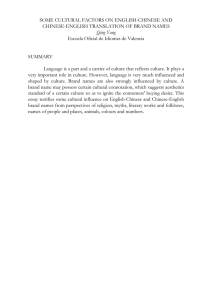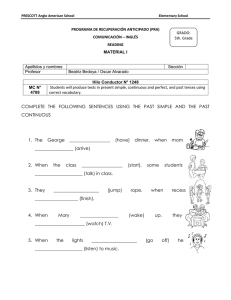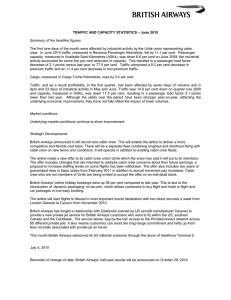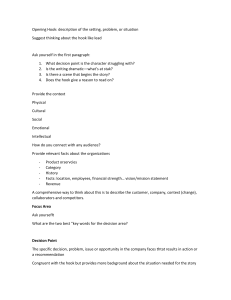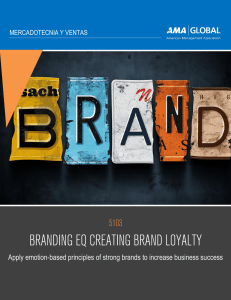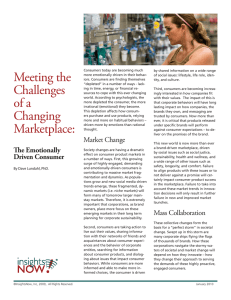The-Role-of-Internal-Communication-and-Training-in-Infusing-Corporate-Values-and-Delivering-Brand-Promise-Singapore-Airlines-Experience2007Corporate-Reputation-Review
Anuncio
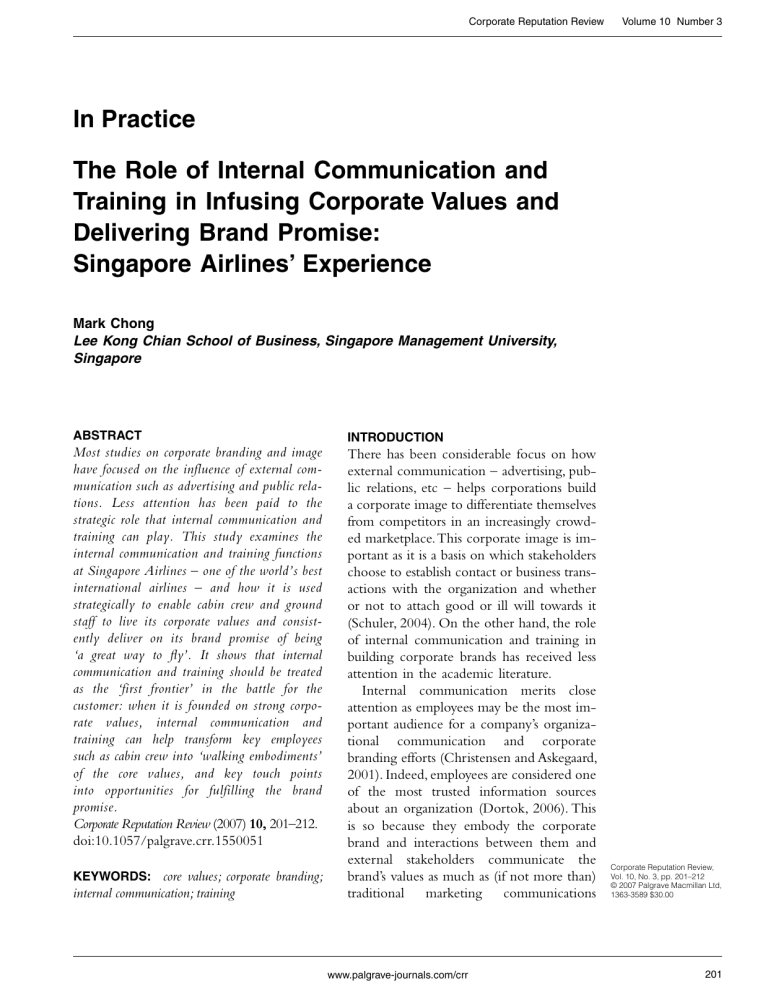
Corporate Reputation Review Volume 10 Number 3 In Practice The Role of Internal Communication and Training in Infusing Corporate Values and Delivering Brand Promise: Singapore Airlines’ Experience Mark Chong Lee Kong Chian School of Business, Singapore Management University, Singapore ABSTRACT INTRODUCTION Most studies on corporate branding and image have focused on the influence of external communication such as advertising and public relations. Less attention has been paid to the strategic role that internal communication and training can play. This study examines the internal communication and training functions at Singapore Airlines – one of the world’s best international airlines – and how it is used strategically to enable cabin crew and ground staff to live its corporate values and consistently deliver on its brand promise of being ‘a great way to fly’. It shows that internal communication and training should be treated as the ‘first frontier’ in the battle for the customer: when it is founded on strong corporate values, internal communication and training can help transform key employees such as cabin crew into ‘walking embodiments’ of the core values, and key touch points into opportunities for fulfilling the brand promise. Corporate Reputation Review (2007) 10, 201–212. doi:10.1057/palgrave.crr.1550051 There has been considerable focus on how external communication – advertising, public relations, etc – helps corporations build a corporate image to differentiate themselves from competitors in an increasingly crowded marketplace. This corporate image is important as it is a basis on which stakeholders choose to establish contact or business transactions with the organization and whether or not to attach good or ill will towards it (Schuler, 2004). On the other hand, the role of internal communication and training in building corporate brands has received less attention in the academic literature. Internal communication merits close attention as employees may be the most important audience for a company’s organizational communication and corporate branding efforts (Christensen and Askegaard, 2001). Indeed, employees are considered one of the most trusted information sources about an organization (Dortok, 2006). This is so because they embody the corporate brand and interactions between them and external stakeholders communicate the brand’s values as much as (if not more than) traditional marketing communications KEYWORDS: core values; corporate branding; internal communication; training www.palgrave-journals.com/crr Corporate Reputation Review, Vol. 10, No. 3, pp. 201–212 © 2007 Palgrave Macmillan Ltd, 1363-3589 $30.00 201 The Role of Internal Communication and Training in Infusing Corporate Values and Delivering Brand Promise (de Chernatony, 2002). Perhaps nowhere is this more important than in service industries where employees are routinely the contact point between a company’s internal and external environments and where the interactions or ‘moments of truth’ (Gummeson, 1999) can deliver the brand promise and create a powerful image and experience among customers through appropriate behavior – or not (Hardaker and Fill, 2005). Thus, service companies need to instill shared understandings of their brand values in the hearts and minds of employees to enhance brandsupporting behaviors (Vallaster and de Chernatony, 2005). Employees who are aligned with the company’s values can help their organization attain a sustainable competitive advantage by giving external stakeholders experiences of these values. Thus, ‘employees represent significant brand value and an organization’s leadership has a responsibility to marshal this opportunity’ (Hardaker and Fill, 2005: 375). Ackerman (2000) argues that employees need to know the identity of their corporation so they can play a critical role in making it ‘known’ to stakeholders. Nonetheless, it is not good enough that employees understand the company’s brand values and have the right skills if the goal is to be ‘brand ambassadors’: they also have to believe in and internalize the brand values through the enactment of appropriate behaviors (Vallaster and de Chernatony, 2005). Effective corporate branding requires all company employees to adopt and behave according to a company’s set of core values (Collins and Porras, 2002; Harris and de Chernatony, 2001). Thus, strong corporate brands are associated with employees who are closely aligned with the core corporate values (Ackerman, 2000). Values1 are especially important as they are at the core of the corporate brand, are critical to how service brands differentiate themselves, and can inspire behavioral changes, motivation and commitment (Durgee et al., 1996; Jones, 1999; Schultz et al., 2000). For example, 202 Corporate Reputation Review Vol. 10, 3, 201–212 values can guide how an organization and its employees deal with the uncertainty that is inherent in uncontrollable or difficult events and thus predict most observable, ‘artifactual’ behavior2 (Schein, 1992). The synergy between corporate values, employees’ effective enactment of these values and customers’ appreciation of them is critical to the success of a corporate brand. In fact, it is precisely the interactions between the value-providing behavior of a company’s employees and the value-seeking behavior of customers that sustain ongoing communication between internal and external shareholders (de Chernatony and Dall’Olmo Riley, 1999; de Chernatony, 2002). When employees understand and are aligned with the core values, they have a better appreciation of their roles and higher commitment to delivering the brand promise, resulting in higher brand performance. For example, shared values have been shown to explain employees’ customer-directed service behaviors that go beyond their formal job descriptions or role requirements (Bettencourt and Brown, 1997; Maxham and Netemeyer, 2003). Conversely, it would be considerably more difficult for employees to enact a company’s core values if there is a misalignment between the corporation’s and employees’ values (Heskett, 1987; Kotter and Heskett, 1992; de Chernatony, 2002). Nonetheless, values that are not internalized (ie espoused values) may mean that employees will say one thing in a given situation and actually do something quite different altogether. Thus, ‘a company may say that it values people and has high quality standards for its products, but its record in that regard may contradict what it says’ (Schein, 1992: 21). As employees inadvertently communicate corporate values through their behavior (Kennedy, 1977; Post and Griffin, 1997; Saxton, 1998), organizations need to help employees internalize the organization’s core values in their attitudes and behavior through communication, training © 2007 Palgrave Macmillan Ltd. 1363-3589 $30.00 Chong and the allocation of rewards and punishment (Ashforth and Mael, 1989; Schein, 1992; Stuart, 1999; de Chernatony, 1999; Andriopoulos and Gotsi, 2001). As companies ‘increasingly compete based on their ability to express who they are and what they stand for’ (Schultz et al., 2000: 80), service brands need to depend on internal communication to empower employees to deliver on the brand promise – regardless of consumers’ point of contact (Camp, 1996; Cleaver, 1999; Hardaker and Fill, 2005). If employees understand the company’s goals and their own role in achieving them, they are more likely to want and be able to support these goals in their interactions with external stakeholders (Zyman, 2002). Companies that attach higher importance to internal communication (such as setting up a separate internal communication department) are known to have higher levels of employee engagement (Thomson and Hecker, 2000) and better reputations (Dortok, 2006). Nonetheless, internal communication must be a two-way affair, as ‘successful corporate brands are characterized by participative approaches whereby senior management provide guidance about their core values, but find mechanisms to engage staff in discussions about their values to encourage a mediated, consensus view’ (de Chernatony, 2002: 119). This is similar to the two-way symmetrical model of public relations which is characterized by a dialogue rather than a monologue, in that the organization is as likely to be influenced by the receiver’s communication as vice versa.This model involves the use of ‘bargaining, negotiating, and strategies of conflict resolution to bring about symbiotic changes in the ideas, attitudes, and behaviors of both organization and its publics’ (Grunig et al., 1995: 169). Grunig and Grunig (1992) argued that this model is the most ethical approach to public relations and ethical public relations is the most effective model for meeting organizational goals. It is simply insufficient for a company to write down its vision and values and hope that employees will ‘live’ them. Instead, the company must engage its employees in a dialogue about what the vision and values mean to them if it hopes to have the vision and values internalized by employees (Bennis, 1997). This is borne out in a recent Gallup survey which showed that employee disengagement is related to lack of communication with management (Liang, 2006). Perhaps never have employees played a more critical role in organizational success than in an emerging ‘experience economy’. In such an economy, the consumer is a ‘guest’ who is looking for a highly personal and memorable contact with the brand. Thus, creating indelible impressions – the ‘takeaways’ of the experience – on customers with positive cues is of paramount importance (Pine and Gilmore, 1998). British Airways, for example, goes beyond the function (ie the travel itself) and competes on the basis of providing a distinctive en route experience that transforms air travel into an ‘oasis’ for the hectic traveler (Prokesch, 1995). Companies such as Disney and Southwest Airlines are also a paradigm of good employee communication. Each employee (called a ‘cast member’) at Disney’s theme parks receives training on how to deliver on the company’s four promises – safety, courtesy, efficiency and entertainment – to its valued customers (called ‘guests’) (Zyman, 2002). Brand values play a critical role in this ‘experience economy’ because they drive employee behavior, and ‘values enacted by employees notably determine the success of the service encounter in the eyes of the consumer’ (de Chernatony and Drury, 2004: 75). On their part, consumers are generally attracted to service brands that are perceived as having values congruent to their own and this gravitation occurs primarily through the value-enacting behavior of customer-facing employees (Wilson, 2001; Davies and Chun, 2002; de Chernatony and Drury, 2004). © 2007 Palgrave Macmillan Ltd. 1363-3589 $30.00 Vol. 10, 3, 201–212 Corporate Reputation Review 203 The Role of Internal Communication and Training in Infusing Corporate Values and Delivering Brand Promise The potential variability and highly personal nature of service brand offerings makes it critical for organizations to align staff behavior with core brand values (LePla and Parker, 1999). Internal communication and training perform this alignment by fostering the internalization of brand values by employees, which bolsters their commitment to enact brand-supporting behaviors (Thomson et al., 1999). In turn, these brand-supporting behaviors – when performed consistently over a period of time – ensure that customers (or guests) have the most personal and memorable experience of the brand’s promise. SINGAPORE AIRLINES Launched in 1972, Singapore Airlines (SIA) is a globally renowned brand and one of the most profitable airlines in the world. Its world-class service, innovative offerings and modern fleet have won the company numerous international accolades over the years. In 2005, for example, SIA was voted ‘best airlines company’ by Conde Nest Traveler and ‘world’s best international airline’ for the tenth consecutive year by Travel + Leisure magazine. In 2006, SIA was ranked one of the world’s most admired 20 companies by Fortune magazine. It was the only airline to make the grade and one of only two Asian companies in the list (the other was Toyota) (Demos, 2006). SIA’s core promise focuses on the in-flight experience – the personal service and service-related comforts – which is embodied by the airline’s now famous sarong kebayaclad stewardesses.Thanks to a highly successful branding campaign, the SIA stewardess has become an international icon known affectionately as ‘the Singapore Girl’. The ‘Singapore Girl’ is the essence of SIA’s unique style of service. She ‘mirrors her Asian heritage – natural femininity, natural grace and warmth, and a natural, gentle way with people’ (Batey, 2002: 120). To ensure that customers get the best in-flight experience, SIA has also pioneered a number of services 204 Corporate Reputation Review Vol. 10, 3, 201–212 ‘firsts’ in the airline industry, including offering ‘the largest drink menu in the skies, the largest complement of cabin crew, and the most comfortable seats’ (Batey, 2002: 136). Nonetheless, SIA and other international airlines are facing a number of significant challenges that threaten their profitability and survival (The new millennium has already witnessed the bankruptcy of several airlines such as SwissAir and Northwest Airlines.) These include the entry of low-cost carriers (such as JetStar Asia and Tiger Airways in Asia), the escalating cost of fuel and global terrorism. SIAs’ service, operations and brand have been the subject of widespread admiration. There has been, however, no systematic investigation on how the company’s internal communication and training practices help it to consistently deliver on its brand promise and maintain its premium positioning in the cutthroat aviation business.3 This paper is possibly the first attempt to answer this question. METHOD This study was conducted from May to July 2006 and involved face-to-face interviews with senior managers of SIA’s People Networks and Cabin Crew Training departments. In addition, the researcher observed the proceedings of a course (called ‘The Magic of SOAR’) conducted by the Cabin Crew Training department for cabin crew trainees. These interviews and observations were supplemented with analysis of corporate presentations, SIA’s website and corporate publications as well as conversations with cabin crew trainees at the SIA Training School in July 2006. The grounded theory method (Glaser and Straus, 1967) was used in analyzing the interviews, observations and communication materials. The researcher’s analysis was validated by the vice-president of the People Networks department and the senior manager of the Cabin Crew Training department. © 2007 Palgrave Macmillan Ltd. 1363-3589 $30.00 Chong FINDINGS Internal Communication at SIA SIA’s employee communication program is based on the mission and key corporate values of the company. SIA’s mission is to be ‘a global company dedicated to providing air transportation services of the highest quality and to maximizing returns for the benefit of its shareholders and employees’. Its core corporate values are the pursuit of excellence, safety, customer first, concern for staff, integrity and teamwork. SIA had 13,760 employees worldwide (as of April 2006). Of these, cabin crew members make up the single largest group (49 per cent). The rest of the employees comprise overseas staff (16 per cent), pilots (15 per cent), ‘rank and file’ staff (12 per cent), administrative officers (6 per cent) and managers (2 per cent). Cabin crew and pilots, who collectively make up 64 per cent of all employees, represent an internal communication challenge as they are always ‘on the move’ and almost never in one place altogether at the same time. The employee communication function resides within the People Networks department, which in turn reports to the Senior Vice-President of Human Resources, who is a member of the management committee that makes the executive decisions for the company. The SVP of Human Resources reports directly to the Chief Executive Officer. Formerly the Employee Communications department, the People Networks department owes its names to a reorganization of the Human Resources division in July 2005 that was carried out to better reflect the philosophy that human resources should focus on people rather than functional processes. Thus, the People Networks department focuses on building and maintaining strong relationships among management and employees by communicating the company’s mission, core values and strategic directions through a comprehensive and integrated communication network that comprises print materials, online communication channels, face-to-face meetings, bond-building extra-curricular activities and the organizational climate survey. The number of communication tools at SIA is impressive for its comprehensiveness and specificity. Print publications such as Outlook are supplemented with more timely electronic bulletin boards and email updates. Moreover, it has channels that are tailored to the specific communication needs of its very important cabin crew and pilots. For example, the Cabin Crew Division produces three publications specifically for the cabin crew. Highpoint is a monthly newsletter that features cabin crew events and passenger comments. Cabin Crew Circulars are bi-weekly updates on service procedures, rules and regulations, security and safety guidelines. In addition, it sends out electronic news online through a cabin crew online portal and mass email updates for urgent announcements. There are also pre-flight briefings conducted by in-flight supervisors or the chief steward/stewardess as well as cabin crew business meetings and fleet meetings for pilots. Nonetheless, what makes SIA stand out is the number of face-to-face communication channels. Meetings and road shows enable employees to engage management directly and are tailored to the communication needs of different employee groups. In Sync is a fortnightly ‘meet the people’ session in which the Senior Vice President of the Cabin Crew division meets cabin crew on an informal basis; anyone can talk about anything in freewheeling and open-ended sessions. Then, there are dialogue sessions and ward gettogethers that allow cabin crew and management to address specific issues and express their views in face-to-face settings. In addition, ‘road shows’ give senior management the opportunity to communicate key issues and new initiatives directly and to obtain feedback from the ground. SIA also conducts focus groups: these are agenda-driven and © 2007 Palgrave Macmillan Ltd. 1363-3589 $30.00 Vol. 10, 3, 201–212 Corporate Reputation Review 205 The Role of Internal Communication and Training in Infusing Corporate Values and Delivering Brand Promise focus on generating cabin crew insights on topics such as organizational climate. According to Mitchell (2002: 102), ‘There’s no substitute for personal contact from the organization’s highest levels’. It is significant that union members are involved in all meetings and training sessions – their involvement helps to break down walls between unions and management and inculcate a sense of ownership. At SIA it seems, there is no such thing as ‘over communication’. Last, SIA administers the organizational climate survey to the approximately 11,000 employees working in its Singapore headquarters. The first voluntary organizational climate survey conducted in August/ September 2005 yielded a response rate of 57 per cent. Survey results are communicated through several of its communication channels. Significantly, the results are factored into the performance assessment of the company’s heads of departments. SIA aims to conduct the survey every two years to benchmark progress in key performance areas, including communication. The communication emphasis is important as ‘making communication an integral part of any performance review will guarantee that this value permeates all levels of an organization (Argenti and Forman, 2002: 144). Infusing Corporate Values SIA’s relentless communication of its core values reflects their strategic status in the company’s internal communication and training programs. Accordingly, the company’s six core values are communicated to all employees at four different ‘touch points’ in their tenure: when they first join the company, when they attend training programs, when they attend corporate events and through corporate communication channels such as Outlook. When non-cabin crew employees first join SIA, they undergo an induction program that includes a segment on the company’s core values. In addition to showing 206 Corporate Reputation Review Vol. 10, 3, 201–212 new employees the SIA core values video, the trainers use actual cases to explain what it means to adopt the core values at the workplace, thus showing how these values can help employees to convey and live the brand promise. Core values are also reiterated during ongoing training programs such as the New Managers’ Program for newly promoted managers and team-building courses. The company’s senior managers (including the Chairman and CEO) also harp on the importance of living the core values when they speak at major events such as the Long Service Awards ceremony and other company functions. According to Cheney (1983), senior executives play a crucial role in influencing and persuading employees to identify with the corporation and develop a distinctive corporate identity.The core values are also printed on the second page of each issue of Outlook magazine and each employee is given a pocket-sized copy of the core values statements. By incorporating these core values into employees’ key touch points, SIA aims – over time – to infuse them into employees to the extent that they ‘live’ these values. And when they do, ‘customers are much more likely to experience the company in a way that’s consistent with what you’ve promised’ (Mitchell, 2002: 100). SIA has an evaluation system in place to ensure that core values are aligned with behavior. In fact, demonstration of behavioral alignment with the company’s core values is one of the performance indicators in the employee’s annual performance appraisal. When there are shortfalls, the supervisor (in consultation with the employee) will recommend remedial activities or provide additional supervision. The performance of crew members is measured using an on-board assessment (OBA) which is carried out by a more senior crew member on the same flight. Significantly, the OBA incorporates performance indicators that reflect the company’s core values, such as service orientation © 2007 Palgrave Macmillan Ltd. 1363-3589 $30.00 Chong and product knowledge (pursuit of excellence), safety and security (safety), and work relationship and people management (teamwork). (Heracleous et al., 2006). The OBA is reinforced by a strong sense of collective destiny which developed historically from SIA’s early days when its employees knew that the Singapore state – its majority owner – would not subsidize the airline to keep it financially viable. The company’s evaluation and reward system sustains this feeling by encouraging peer pressure to perform (Heracleous et al., 2006). Cabin Crew: The Crucial ‘Touch Point’ SIA’s cabin crew are undoubtedly the critical touch point between the organization and its passengers.Thus, cabin crew members attend the airline industry’s longest basic training program – four months – to ensure that they embody SIA’s corporate values and realize the promise of being ‘A Great Way to Fly’. This training focuses not only on functional skills but also ‘soft’ skills such as intercultural communication, personal poise and negotiation skills involved in dealing with demanding passengers (Davis, 1996). Nonetheless, new cabin crew members are invited to join the company only after undergoing a rigorous three-stage interview process that weeds out candidates whose personal values are divergent from the company’s. Indeed, employees who ‘share an organization’s values are more likely to feel like an integral part of the system, taking ownership in and responsibility for the firm and its performance’ (Maxham and Netemeyer, 2003: 58). Once they join SIA, the training serves to enhance alignment between the cabin crew’s personal value system and SIA’s corporate values. From the start, trainees are expected to start manifesting these values – such as greeting and making eye contact with everyone they come into contact with – so that they gradually but surely become an integral part of the ‘Singapore Girl’ that they are aspiring to be.4 In short, cabin crew members are groomed to be ‘walking’ embodiments and manifestations of these core values. For example, one of the core corporate values is ‘customer first’. Thus, cabin crew members are expected to put on a smile and take care of their passengers even when they are under duress. The ‘pursuit of excellence’ is another core value which is manifested in the impeccable poise and service of the cabin crew. To attune cabin crew to the cultural characteristics and sensitivities (eg taboos) of their multinational market, SIA gets experienced international crew members to impart in training programs their knowledge of the verbal and behavioral subtleties exhibited by their own cultures. In addition, SIA offers free language-and-culture classes aimed at enhancing crew’s understanding of their passengers. Training does not stop after the fourmonth immersion program – it goes on for the entire term of employment. These programs continually reinforce the alignment of personal with corporate values through the communication and sharing of core valueaffirming experiences. After all, ‘identification is not a one-time, all or nothing process whereby individuals come to match their values with their organization. It is an ongoing process that requires adequate management attention’ (Andriopoulos and Gotsi, 2001: 153). SOAR – ‘Service Over and Above the Rest’ – is a good example of the above philosophy. Launched in 2003, the training program aims to realize SIA’s mission of providing in-flight service that far exceeds the competition. SOAR inculcates a unique set of values that are aligned with the core values but which are articulated in a form that resonates best with cabin crew. For example, the SOAR value of ‘A passenger’s smile makes it all worthwhile’ is linked to the core value of ‘Customer First’. So, despite the existence of core values, companies sometimes find it necessary to have © 2007 Palgrave Macmillan Ltd. 1363-3589 $30.00 Vol. 10, 3, 201–212 Corporate Reputation Review 207 The Role of Internal Communication and Training in Infusing Corporate Values and Delivering Brand Promise customized messages or distinctive employee value propositions for different employee sub-segments (Martin and Hetrick, 2006). A typical SOAR session is based on the sharing of scenarios and situations actually encountered by other cabin crew in the past. This sharing intensifies the learning and bonding between participants as they come to a common understanding of the SOAR values and their enactment in a wide variety of circumstances. The training derives much of its credibility and immediacy from the fact that it is often conducted by senior cabin crew members who have often personally experienced those situations. The degree of attention to communication in SOAR is nothing short of impressive. A one-day session that this researcher attended featured modules on interpersonal and intercultural communication skills. In the interpersonal communication module, for example, the topic of body language alone covered facial expression, eye movement, posture, gestures, personal space, breathing and appearance. The sub-topic of posture was a mini-lesson in and of itself: trainees learnt (among other things) to always position themselves perpendicularly and bend forward when speaking with a guest – these ‘postures’ communicate the avoidance of confrontation and the eagerness to serve, respectively. SIA cabin crew trainees this researcher spoke to described their fourmonth training stint as ‘grueling’ but reported positive transformations in their attitudes toward people and service. Nonetheless, cabin crew can only manifest their core and SOAR values to the extent that their internal stakeholders would allow them to – misunderstanding, miscommunication or a lack of cooperation from ground and engineering staff can potentially derail their best efforts. SIA’s Fus3ion course aims precisely to enhance cooperation among pilots, cabin crew, ground and engineering staff. For example, Fus3ion features a roleplay program that gets pilots to ‘act’ as ground 208 Corporate Reputation Review Vol. 10, 3, 201–212 staff, ground staff to ‘act’ as engineers, engineers to ‘act’ as cabin crew and cabin crew to ‘act’ as pilots. This exercise develops empathy and patience by putting individuals in the shoes of their colleagues. As frontline employees (eg ticketing officers and station managers) also play a significant role in manifesting the company’s core values, they undergo an equivalent training program known as ‘Transforming Customer Service’ (TCS). By ensuring that both crew and noncrew employees share similar understandings of the core values, SIA makes consistent brand-supporting behavior possible across different customer ‘touch points’ (see Mohammed and Ringseis, 2001;Vallaster and de Chernatony, 2005). Indeed, non-crew members’ understanding of SIA’s core values is borne out by the company’s 2005 Organizational Climate Survey, wherein 83 per cent of non-crew employees indicated that they had a clear understanding of the company’s objectives and goals. These noncrew employees also recognize the effectiveness of internal communication and training programs: in post-course evaluations, more than 75 per cent of non-crew employees rated values-related and team-building training programs as being ‘above average’. Noncrew participants also felt that they had a better understanding of the company and its culture after attending these courses.5 So, in summary, SIA’s core values form the bedrock of its internal communication and training programs, which work in mutually reinforcing ways to internalize these values in cabin crew and other employees to empower them to deliver on SIA’s brand promise of ‘A great way to fly’. Soenon and Moingeon’s (2002) multifaceted model of corporate identity offers a holistic way of showing how internal communication and training contribute to the alignment of different aspects of SIA’s identity. These five facets are: the professed identity, the projected identity, the experienced identity, the manifested identity and the attributed identity. © 2007 Palgrave Macmillan Ltd. 1363-3589 $30.00 Chong Professed identity refers to ‘what a group or organization professes about itself ’ (Soenen and Moingeon, 2002: 18). Nonetheless, scholars and practitioners often study the professed identity only when it is projected towards specific audiences through various communications (ie when it becomes the projected identity). Projected identity refers to ‘the elements an organization uses, in more or less controlled ways, to present itself to specific audiences’ (Soenen and Moingeon, 2002: 18). Perhaps the most visible and well-known aspect of SIA’s projected identity for external audiences is the image of the ‘Singapore Girl’. As mentioned earlier, the ‘Singapore Girl’ is the essence of SIA’s unique style of service. Another prominent aspect of its externally projected identity is its positioning as an innovative airline that offers its guests the latest and best in in-flight services. An example of this would be its current tagline of being ‘First to fly the A380’ (the world’s largest passenger aircraft) which is expressed in all its above and below-the-line communication. Internally, its projected identity is enshrined in its six core values, which are conveyed and reinforced through internal communication and training programs. Experienced identity refers to ‘what organizational members experience, more or less consciously, with regard to their organization’ (Soenen and Moingeon, 2002: 19). Manifested identity refers to an organization’s ‘historical identity’ or ‘elements that have characterized the organization over a period of time’ (Soenen and Moingeon, 2002: 20). Over the past 15–20 years, SIA has been synonymous with innovation and world-class service. The company has had a history of ‘firsts’: for example, it was the first commercial airline in the world to fly nonstop from London to Singapore (1989); introduce a satellite-based in-flight telephone service (1991); offer audio and videoon-demand capabilities in its in-flight entertainment systems (1997); bring together a comprehensive panel of world-renowned chefs to develop in-flight meals (2001) and operate the world’s longest non-stop commercial flight between Singapore and Los Angeles and between Singapore and New York (2004). In 2007, it will become the world’s first airline to fly the A380. Its commitment to cultivating and delivering worldclass service is manifested in its religious commitment to cabin and ground crew training. Attributed identity, which refers to ‘attributes that are ascribed to the organization by its various audiences’ (Soenen and Moingeon, 2002: 20), is reflected in the international accolades heaped on the company (see http://www.singaporeair.com/ saa/en_UK/content/company_info/news/ achievements.jsp). SIA’s projected identity is an outcome of its internal communication and training – publications such as the Outlook newsletter and training programs such as SOAR formally communicate and reinforce the company’s core values. When employees internalize core values and consistently project them in the form of brand-supporting behaviors over a period of time, the projected identity becomes manifested identity. Brand promise may be said to be delivered when manifested identity is expressed consistently over a period of time. Attributed identity is formed when external parties confer awards and other accolades on SIA’s manifested identity. Based on the fact that SIA has won more than close to 300 international awards for excellence in service and innovation in just the last four years – 67 in 2002, 59 in 2003, 82 in 2004 and 72 in 2005 – one can infer that SIA’s customers have an extremely positive perception of its service offerings.These awards show that internal communication and training have translated into the delivery of its brand promise of ‘A Great Way to Fly’. Thus, there is a relationship between internal communication and the delivery of brand promise. SIA feeds this attributed identity back © 2007 Palgrave Macmillan Ltd. 1363-3589 $30.00 Vol. 10, 3, 201–212 Corporate Reputation Review 209 The Role of Internal Communication and Training in Infusing Corporate Values and Delivering Brand Promise Projected Identity Manifested Identity Experienced Identity Attributed Identity Figure 1: Relationship among various dimensions of SIA’s corporate identity to its employees through internal communication vehicles and training programs, thus reinforcing and qualifying employees’ experienced identity. Thus, 86 per cent of employees opined in the 2005 Organizational Climate Survey that SIA is highly regarded by the general public, customers, competitors and employees. Aspects of this experienced identity in turn feed into SIA’s projected identity, for example when employees share their personal experience of the core values in training sessions and internal publications. Graphically, the four facets form a feedback loop, with internal communication and training programs providing the crucial conduit (Figure 1). CONCLUSIONS This paper has shown how internal communication and training enable SIA to consistently deliver on its brand promise to become the world’s most successful international airline. Unlike most studies to date, which have focused on the influence of external communication on the corporate image and brand, this paper shows the strategic role internal communication can play in an organization – especially when it is founded on the organization’s core values and intertwined with a training program that borders on zealotry. What distinguishes SIA’s internal communication is its firm focus on faceto-face dialogue between management and staff as well as communication channels that are tailored to the needs of specific internal 210 Corporate Reputation Review Vol. 10, 3, 201–212 stakeholders (eg cabin crew). In addition, it is single-mindedly dedicated to the goal of infusing employees – particularly its important cabin crew – with the core values through regular training programs so that they become ‘walking’ and ‘living’ embodiments of the corporate brand. And there is perhaps no better icon of SIA’s core values than the ‘Singapore Girl’.6 In the increasingly globalized and high-risk aviation industry, internal communication and training are the first frontiers where the battle for the consumer is fought and won – or lost. Acknowledgments The author wishes to express his sincere thanks to Mr Chew Kai Seng, Ms Iris Tee and Ms Lam Seet Mui of Singapore Airlines for their invaluable assistance throughout this study. He is also extremely grateful to the Editor and two anonymous reviewers for their extremely helpful comments on the first draft of this paper. NOTES 1 A value is ‘an enduring belief that a specific mode of conduct or end-state of existence is personally or socially preferable to an opposite or converse mode of conduct or end-state of existence’ (Rokeach, 1973: 5). 2 Artifactual behavior would include language, manners of address, clothing and published lists of values (Schein, 1992). 3 The focus on internal communication is justified as it is the driving force that ensures the coherent transfer of brand values to employees (Vallaster and de Chernatony, 2005). 4 The author experienced this first hand when observing cabin crew trainees at the SIA Training School. 5 Email correspondence with Iris Tee, People Networks Department, SIA. 6 The ‘Singapore Girl’ has the distinction of being the first commercial figure to be displayed in Madame Tussaud’s Museum in London. REFERENCES Ackerman, L.D. (2000) Identity is Destiny: Leadership and the Roots of Value Creation, Berrett-Koehler Publishers, Inc., San Francisco. © 2007 Palgrave Macmillan Ltd. 1363-3589 $30.00 Chong Andriopoulos, C. and Gotsi, M. (2001) ‘Living’ the corporate identity: Case studies from the creative industry’, Corporate Reputation Review, 4(2), 144–154. Argenti, P.A. and Forman, J. (2002) The Power of Corporate Communication, McGraw-Hill, New York. Ashforth, B.E. and Mael, F. (1989) ‘Social identity theory and the organization’, Academy of Management Review, 14(1), 20–39. Batey, I. (2002) Asian branding: A Great Way to Fly, Prentice-Hall, UK. Bennis, W. (1997) ‘Becoming a leader of leaders’, in R. Gibson (ed.), Rethinking the Future, Nicholas Brealy Publishing, London. Bettencourt, L.A. and Brown, S. (1997) ‘Contact employees: Relationships among workplace fairness, job satisfaction, and pro-social service behaviors’, Journal of Retailing, 73(1), 39–61. Camp, L. (1996) ‘Latest thinking on optimization of brand use in financial services marketing’, Journal of Brand Management, 3(4), 241–247. Cheney, G. (1983) ‘On the various and changing meanings of organizational membership: A field study of organizational identification’, Communication Monographs, 50, 342–362. Christensen, L.T. and Askegaard, S. (2001) ‘Corporate identity and corporate image revisited’, European Journal of Marketing, 35(3/4), 292–315. Cleaver, C. (1999) ‘Brands as the catalyst’, Journal of Brand Management, 6(5), 309–312. Collins, J. and Porras, J.I. (2002) Built to Last: Successful Habits of Visionary Companies, HarperCollins Publishers, New York. Davies, G. and Chun, R. (2002) ‘Gaps between the internal and external perceptions of the corporate brand’, Corporate Reputation Review, 5(2/3), 144–158. Davis, B. (1996) ‘Why Singapore Airlines is the world’s most profitable airline’, Asian Business Review, December, 34–37. de Chernatony, L. (1999) ‘Brand management through narrowing the gap between brand identity and brand reputation’, Journal of Marketing Management, 15(1–3), 157–179. de Chernatony, L. (2002) ‘Would a brand smell any sweeter by a corporate name?’, Corporate Reputation Review, 5(2/3), 114–132. de Chernatony, L. and Dall’Olmo Riley, F. (1999) ‘Experts’ views about defining service brands and the principles of services branding’, Journal of Business Research, 46(2), 181–192. De Chernatony, L. and Drury, S. (2004) ‘Identifying and sustaining services brands’ values’, Journal of Marketing Communications, 10(2), 73–93. Demos, T. (2006) ‘The world’s most admired companies’, Fortune, 153(4), 33–42. Dortok, A. (2006) ‘A managerial look at the interaction between internal communication and corporate reputation’, Corporate Reputation Review, 8(4), 322–338. Durgee, J., O’Connar, G. and Veryzer, R. (1996) ‘Observations:Translating values into product wants’, Journal of Advertising Research, 36(6), 90–99. Glaser, B.G. and Straus, A.L. (1967) The Discovery of Grounded Theory: Strategies for Qualitative Research, Aldine, Chicago. Grunig, J.E. and Grunig, L.A. (1992) ‘Models of public relations and communication’, in J.E. Grunig (ed.), Excellence in Public Relations and Communication Management, Lawrence Erlbaum Associates, New Jersey. Grunig, J.E., Grunig, L.A., Sriramesh, K., Huang, Y. and Lyra, A. (1995) ‘Models of public relations in an international setting’, Journal of Public Relations Research, 7(3), 163–186. Gummeson, E. (1999) Total Relationship Marketing. Rethinking Marketing Management: From 4Ps to 30Rs, Butterworth Heinemann, Oxford, UK. Hardaker, S. and Fill, C. (2005) ‘Corporate services brands: The intellectual and emotional engagement of employees’, Corporate Reputation Review, 7(4), 365–376. Harris, F. and de Chernatony, L. (2001) ‘Corporate branding and corporate brand performance’, European Journal of Marketing, 35(3/4), 441–456. Heracleous, L., Wirtz, J. and Pangarkar, N. (2006) Flying High in a Competitive Industry: Cost-Effective Service Excellence at Singapore Airlines, McGraw-Hill, Singapore. Heskett, J. (1987) ‘Lessons in the service sector’, Harvard Business Review, 65(2), 118–126. Jones, J. (1999) ‘The future of banking: Implications of branding and loyalty’, Journal of Financial Services Marketing, 3(1), 53–66. Kennedy, S.H. (1977) ‘Nurturing corporate images: Total communication or ego trip?’, European Journal of Marketing, 11(3), 120–164. Kotter, J. and Heskett, J. (1992) Corporate Culture and Performance, The Free Press, New York. LePla, J.F. and Parker, L.M. (1999) Integrated Branding: Becoming Brand-Driven through Company-Wide Action, Quorum Books, London. Liang, D. (2006) ‘Money alone can’t buy happiness; lack of feedback is why some employees are unhappy’, Today, 2 March, p. 4. Martin, G. and Hetrick, S. (2006) ‘Driving corporate reputations and brands from the inside: A strategic role for HR’, Paper presented at the 10th Annual Global Reputation Institute Conference, New York, USA. Maxham III, J.B. and Netemeyer, R.G. (2003) ‘Firms reap what they sow: The effects of shared values © 2007 Palgrave Macmillan Ltd. 1363-3589 $30.00 Vol. 10, 3, 201–212 Corporate Reputation Review 211 The Role of Internal Communication and Training in Infusing Corporate Values and Delivering Brand Promise and perceived organizational justice on customers’ evaluations of complaint handling’, Journal of Marketing, 67(1), 46–62. Mitchell, C. (2002) ‘Selling the brand inside’, Harvard Business Review, 80(1), 99–105. Mohammed, S. and Ringseis, E. (2001) ‘Cognitive diversity and consensus in group decision making: The role of inputs, processes, and outcomes’, Organizational Behavior and Human Decision Processes, 85(2), 310–335. Pine II, B.J. and Gilmore, J.H. (1998) ‘Welcome to the experience economy’, Harvard Business Review, 76(4), 97–105. Post, J.E. and Griffin, J.J. (1997) ‘Corporate reputation and external affairs management’, Corporate Reputation Review, 1(1/2), 165–171. Prokesch, S.E. (1995) ‘Competing on customer service: An interview with British Airway’s Sir Colin Marshall’, Harvard Business Review, 73(6), 100–113. Rokeach, M. (1973) The Nature of Human Values, The Free Press, New York. Soenen, G. and Moingeon, B. (2002) ‘The five facets of collective identities. Integrating corporate and organizational identity’, in B. Moingeon and G. Soenen (eds.), Corporate and Organizational Identities: Integrating Strategy, Marketing, Communication, and Organizational Perspectives, Routledge, London. Saxton, K. (1998) ‘Where do reputations come from?’, Corporate Reputation Review, 1(4), 393–399. 212 Corporate Reputation Review Vol. 10, 3, 201–212 Schein, E.H. (1992) Organizational Culture and Leadership, Jossey-Bass, San Francisco. Schuler, M. (2004) ‘Management of the organizational image: A method for organizational image configuration’, Corporate Reputation Review, 7(1), 37–53. Schultz, M., Hatch, M.J. and Larsen, M.H. (2000) The Expressive Organization, Oxford University Press, New York. Stuart, H. (1999) ‘Towards a definitive model of the corporate identity management process’, Corporate Communications: An International Journal, 4(4), 200–207. Thomson, K., de Chernatony, L., Arganbright, L. and Khan, S. (1999) ‘The buy-in benchmark: How staff understanding and commitment impact brand and business performance’, Journal of Marketing Management, 8(15), 819–835. Thomson, K. and Hecker, L.A. (2000) ‘The business value of buy-in’, in R.J.Varey and Lewis B.R. (eds.), Internal Marketing: Directions for Management, Routledge, London, UK. Vallaster, C. and de Chernatony, L. (2005) ‘Internationalisation of services brands: The role of leadership during the internal brand building process’, Journal of Marketing Management, 21(1/2), 181–203. Wilson, A.M. (2001) ‘Understanding organizational culture and the implications for corporate marketing’, European Journal of Marketing, 35(3/4), 353–364. Zyman, S. (2002) The End of Advertising As We Know It, John Wiley, New Jersey. © 2007 Palgrave Macmillan Ltd. 1363-3589 $30.00

